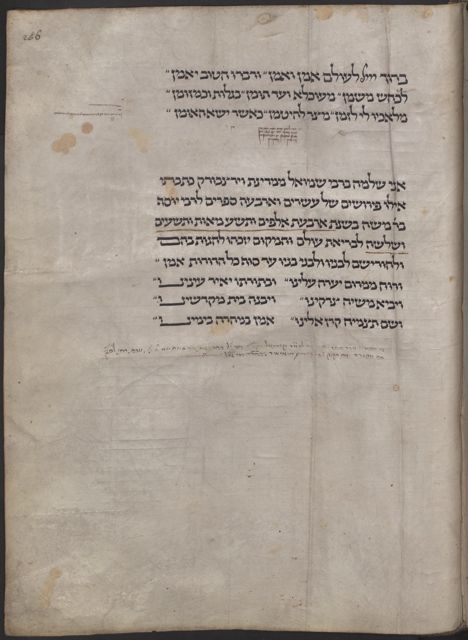Munich, BSB MS. Cod. Hebr. 5(2)
- Details
- Item Images (1)
- Graphic Elements (0)
- Specimens (1)
Details
Munich, BSB MS. Cod. Hebr. 5(2)
Munich Rashi's Commentary on the Bible, Part 2
Bayerische Staatsbibliothek (Munich, Germany)
Item Nature
Codex
Writing
Parchment
Brown (iron-gall)
Quill
Ruling
There is ruling
Hard point
Horizontal lines only, number of ruled lines don't represent the number of written lines in the case of the colophon.
Date
ארבעת אלפים ותשע מאות ותשעים ושלשה לבריאת עולם
1232/3
13th Century CE
Place
Würzburg (origin of the scribe)
Wirzburk (in Franconia, modern Würzburg)
Ashkenaz
Language
Hebrew
Subject Field
- Bible
- Bible commentary
Vowels and Signs
No vowels or accents
Other
Cod. hebr. 5, originally produced as a sumptuous single volume, was divided into two around 1549 after its acquisition by Johann-Jakob Fugger (see Introduction to Fugger manuscripts). Each volume was bound by the Fugger Binder (see Binding). The lost first leaf of vol. I, as well as its last leaf were replaced, copied anew (I:1v, I:218r) by Yishai ben Yehiel and decorated by Meir. Both scribes worked for Fugger in Venice during 1549 and 1552 (see Illuminated Documents of vol. I:1v and vol. II:1r). Before the manuscript was acquired by Fugger in 1549, it was sold in Venice in 1526 by Rabbi Hiya Meir ben David to Yekutiel ben David (cf. inscription below the colophon, II:256). Rabbi Hiya Meir worked with the Venetian printer Daniel Bomberg (Amram 1909:169; Raz-Krakotzkin 2007:105), with whom Fugger had some relations (see Introduction to Fugger manuscripts). Thus it is possible that Fugger acquired this manuscript through Bomberg's printing house. It should be noted that in 1516-17 and 1524-26 Bomberg printed in Venice the first two editions of the Great Scriptures ((מקראות גדולות with Rashi's commentary, from which Yishai could have copied that for Genesis (vol. I:1v). The Style Despite the small illustrated panels, the composition is fairly spacious, even when there is a conflation of scenes, such as Abraham leaving Haran and the destruction of Sodom, Isaac blessing Esau while Jacob leaves the house, Joseph being thrown into the pit and sold to the Ishmaelites, Job with his four friends and his wife, and Nebuchadnezzar and the three Hebrews (I:9v, 21v, 34; II:183, 209). At times our artist used similar compositions where a group of people stands before an authoritative figure, either seated or standing (I:39, 44v, 63a). He also used similar postures and gestures in three other scenes where, in a group of three figures standing in a row, the first is looking ahead while the second turns to the third, all making hand gestures. The style and motifs of our manuscript show close affinities with Latin book illumination produced in Würzburg in the 13th century. This was first mentioned by H. Swarzenski (1936) and reiterated by Narkiss (1967), Engelhart (1987), Suckale (1988) and Klemm (1998, Nos. 194-195).
https://cja.huji.ac.il/browser.php?mode=set&id=2191
https://cja.huji.ac.il/browser.php?mode=set&id=2191
Die hebräische Bibel wurde von vielen jüdischen Gelehrten kommentiert. Einer der berühmtesten ist Rashi (Shelomoh ben Yitshak, 1040-1105) aus Troyes (Nordfrankreich). Die zweibändige Handschrift enthält in erster Linie seinen Kommentar zum Alten Testament mit Ausnahme des Buchs der Sprüche. Die Kommentare zu den großen Propheten und zu einigen Büchern der Hagiographen (in der hebräischen Bibel die Bücher Rut, Psalmen, Hiob, Sprüche, Hohelied, Prediger, Klagelieder, Daniel, Ester, Esra, Nehemia, Chroniken) stammen von anderen Autoren, vornehmlich von Yosef Kara (1065-1130), einem Schüler Rashis. Die Handschrift ist in ihrer Anlage und künstlerischen Gestaltung einmalig. Der in in drei Spalten geschriebene Text enthält nur den Kommentar und nicht, wie sonst üblich, auch den kommentierten Bibeltext. Bemerkenswert ist der Plan für eine aufwändige Illuminierung, der jedoch nur teilweise realisiert wurde. Die Handschrift ist nicht nur die älteste illuminierte hebräische Handschrift deutschen Ursprungs, vielmehr in der Besonderheit ihres Stils und ihres Illustrationsprogramms auch die einzige dieser Art. In den vollendeten 17 farbigen Miniaturen und ornamentalen Elementen lassen sich deutliche Anklänge an die spätromanische christliche Ikonographie erkennen, wie sie in lateinischen illuminierten Handschriften dieser Epoche im Würzburger Umkreis gepflegt wurde. Der Text wurde von zwei Kopisten geschrieben und 1233 vollendet. Beide Bände gelangten im 16. Jahrhundert in die Sammlung von Johann Jakob Fugger, die 1571 vom Herzog von Bayern, Albrecht V., für die Münchner Hofbibliothek, die Vorläuferin der Bayerischen Staatsbibliothek, erworben wurde. // Bayerische Staatsbibliothek, Orient- und Asienabteilung, 2019
(https://www.digitale-sammlungen.de/en/view/bsb00036330?page=12,13)
An Unknown Ashkenazic Torah Scroll from the Early 13th Century : a Palaeographical Study / Farnadi-Jerusálmi, Mark in "Henoch : studi storico-testuali su giudaismo e cristianesimo in età antica e medievale : 43, 1, 2021, Brescia : Editrice Morcelliana, 2021 , 2611-8076 - Casalini id: 5189735" - P. 105-135
(https://www.digitale-sammlungen.de/en/view/bsb00036330?page=12,13)
An Unknown Ashkenazic Torah Scroll from the Early 13th Century : a Palaeographical Study / Farnadi-Jerusálmi, Mark in "Henoch : studi storico-testuali su giudaismo e cristianesimo in età antica e medievale : 43, 1, 2021, Brescia : Editrice Morcelliana, 2021 , 2611-8076 - Casalini id: 5189735" - P. 105-135
Item Images
Munich, BSB MS. Cod. Hebr. 5(2): 256r

Graphic Elements
No records found
This may be because no data of this type exists yet or because your search criteria is too narrow
Specimens
Munich, Cod. Hebr. 5(2): Main text scribe - Square
Bayerische Staatsbibliothek (Munich, Germany)